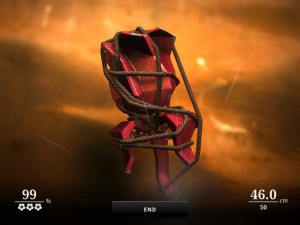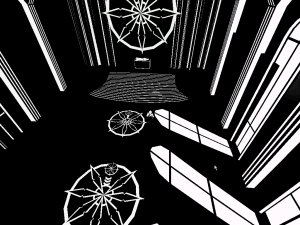I played a little more SMB. I’m still stuck in Hell, but I managed to unlock another character: Ogmo, from the Jumper series. I recall trying one of the Jumper sequels a while back, probably Jumper 3 when it was featured on Play This Thing. It seemed a decent platformer, but I wasn’t in the mood for it at the time. But hey, if there’s one thing I can use SMB for, it’s as a framework for recommendations. Seems to me I should at least try out the games that McMillen liked enough to invite to the party.
So, I looked at the unlockable character roster. So far, I’ve got Ogmo, the Headcrab, Commander Video, and Jill. Ogmo I’ve mentioned; I’ve downloaded the original Jumper and played it a bit, but it gets very difficult very quickly. The Headcrab is from Half-Life. Half-Life isn’t a platformer, and the headcrab isn’t its player character, but I suppose someone wanted a Steam-exclusive unlockable, and this is the only thing in Valve’s library that’s known for jumping. At any rate, I’ve played the heck out of Half-Life (although I need to go through Half-Life 2 again at some point, now that they’ve added Achievements). Commander Video is from Bit.Trip Runner, which is a Wii game, not available on any system I own. One of its predecessors, Bit.Trip Beat, is out for PC, but it looks like a fundamentally different game; if further Bit.Trips are ported, I may get them as a package, but for now, I’ll give it a miss.
Looking at unlockable characters I don’t have yet, I noticed one from a game that had garnered praise but which I hadn’t tried: Runman: Race Around the World, which can be described as Sonic the Hedgehog with everything that isn’t directly related to running fast taken out, including death. Downloading that, I see it’s done in a crudely-doodled style. No surprise there — I could tell that much from the screenshots and demo video. But somehow, seeing it in-game made me look at it better, and it looked very familiar — the drawing style reminded me a lot of An Untitled Story, a Metroidvania-style platformer I had played but not finished a few months ago, concerning an egg that falls from a nest and, after fighting a few bosses, hatches into a bird that fights more bosses. It had art that was clearly drawn with magic marker.
Googling, I discover that, indeed, one of the co-authors of Runman is Matt Thorson, author of An Untitled Story. Furthermore, he wrote the Jumper series, as well as a couple of other platformers I know: Give Up Robot and Moneysieze. I had played Moneysieze quite a lot last year, and meant to write it up here, but never got around to it. It struck me as fairly ingenious in its unconventional use of famliar platformer mechanics. For example, the double-jump. In many platformers, you can hit the jump button a second time at the top of your arc to gain additional height. In Moneysieze, you could perform the second jump at any point in your trajectory — which means you can use it to pass under obstacles that extend below your starting point. I thought this was clever, but now I see that the same author had already pulled tricks like this in Jumper. SMB treats the double-jump as Ogmo’s defining trait, and the warp zone where you acquire Ogmo for general use requires executing trick jumps of exactly this sort.
I’m a little shocked to discover how much of Thorson’s work I’ve experienced without being aware of him. I notice now that the Play This Thing writeup of Jumper 3 actually mentions that Thorson is half of the Runman team, but apparently that fact made no impression on me at the time. Well, if part of SMB‘s mission is increased awareness of indie platformers, mission accomplished. I considered myself pretty aware already, but it looks like I wasn’t aware of my lack of awareness. I’ll be watching for Thorson’s name in the future.
Also, for what it’s worth, Runman‘s level-selection screen plays a recording of Helen Humes singing Song of the Wanderer, the same background music as the level-selection screen for Immortal Defense. I suppose there are only so many public-domain jazz recordings out there, and Runman uses many of them, but unless this is a deliberate reference, it’s a strange coincidence. Or maybe there’s just something about that song that suggests “level select screen” to indie developers? I’m definitely going to use it for that purpose if I ever write a game with a level-select screen. It’s too good an in-joke not to share.
 Comments(0)
Comments(0)


